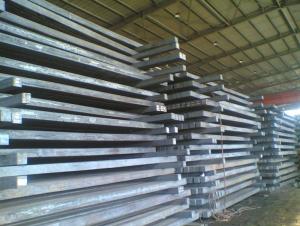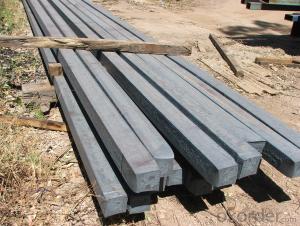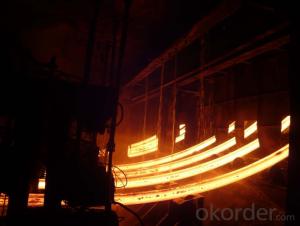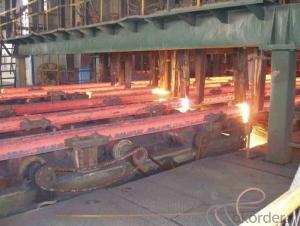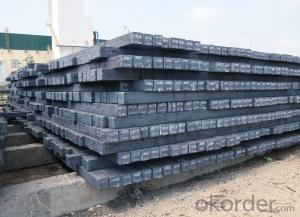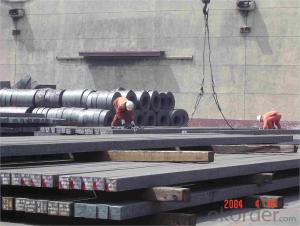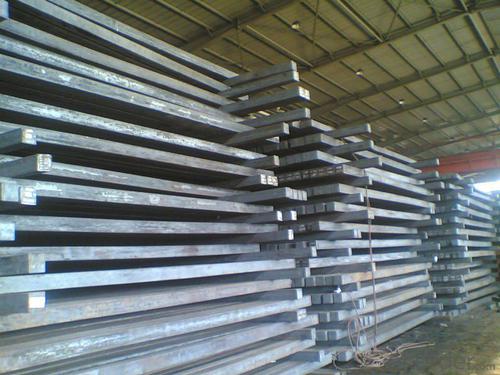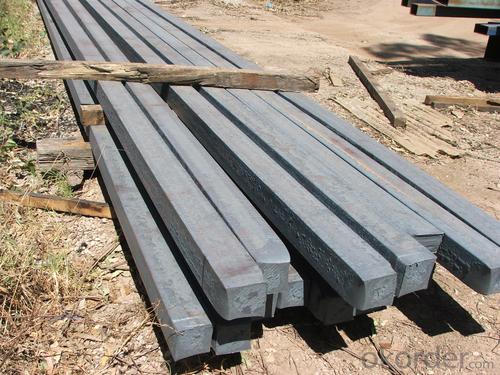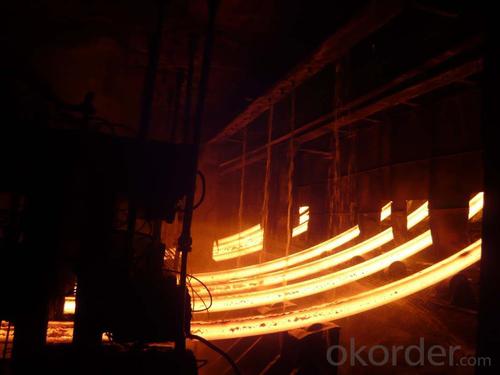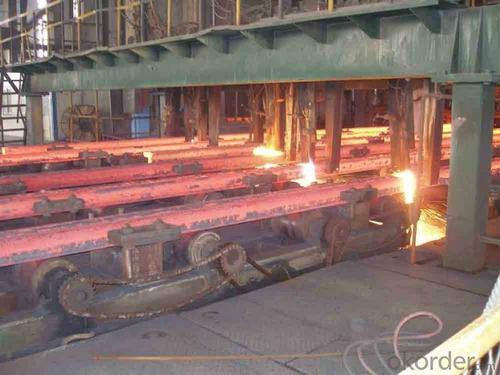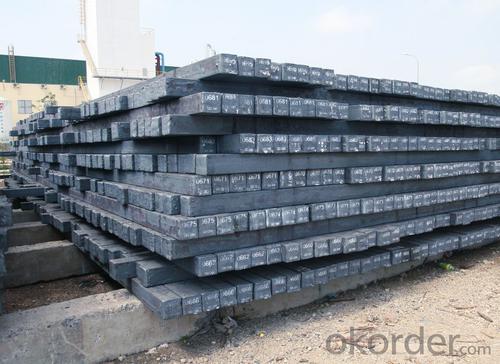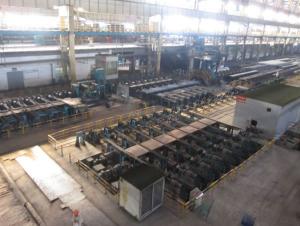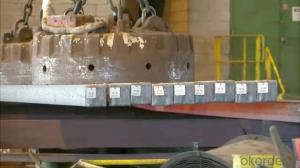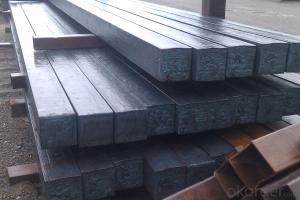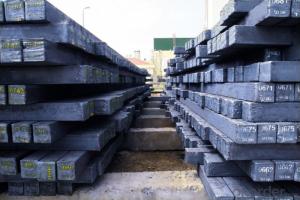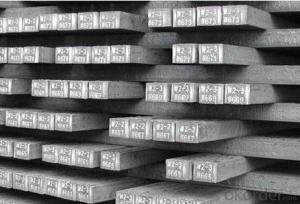Q235/3SP 175MM Blast Furnace Hot Rolled Steel Billet
- Loading Port:
- Tianjin
- Payment Terms:
- TT OR LC
- Min Order Qty:
- 2000 m.t.
- Supply Capability:
- 30000 m.t./month
OKorder Service Pledge
OKorder Financial Service
You Might Also Like
Description of Q235/3SP 175MM Blast Furnace Hot Rolled Steel Billet
Our hot dip galvanised steels consist of a steel substrate with a metallic zinc coating applied by means of a continuous hot dip galvanising process. Metallic zinc coatings are available in steel grades ranging from steel for bending and deep drawing applications, to structural steels and high yield strength steels.
A glossy surface finish obtained under specific skin-pass conditions (either non-skin-passed or skin- passed with smooth cylinders to obtain low roughness) can be provided if required at time of enquiry.
Advantage of Q235/3SP 175MM Blast Furnace Hot Rolled Steel Billet
Uncoated CR steel sheet With the features of in line with the international highest standards in demension and shape, excellent surface finish and properties, the products are mainly used in home appliance and automobile industries.
Galvanized steel sheet(include HDG and EG)
With the features of good corrosion resistance, the products are mainly used in automobile, home appliance, electronics, building and machinery manufacture industries, etc.
Precoated steel sheet With the features of enviromental protection and good processablility, long lasting surface durability, rich in colors, the products are maily used in building, home appliance and furniture industries, etc.
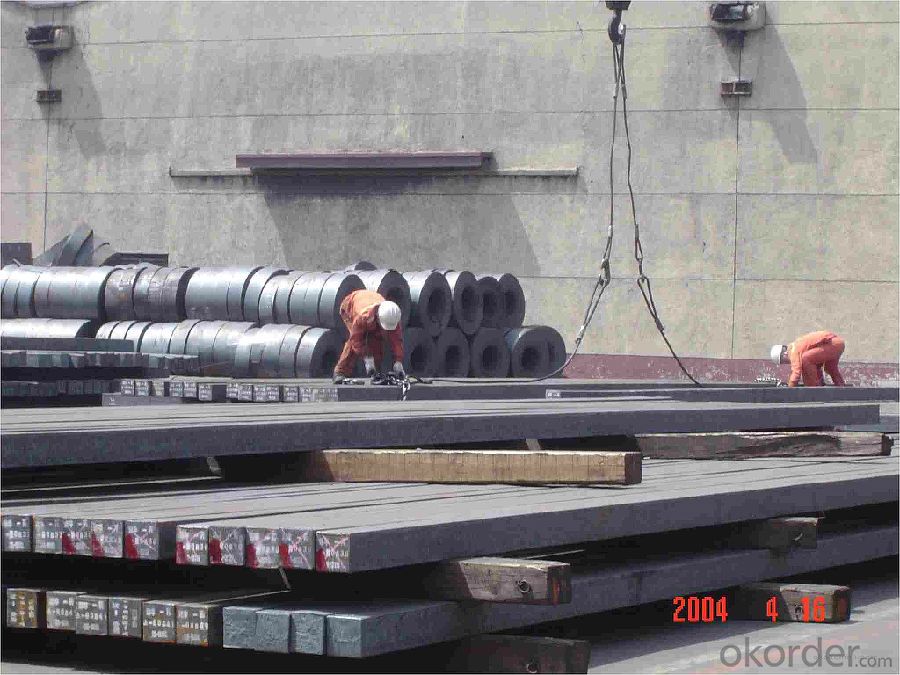
Applications of Q235/3SP 175MM Blast Furnace Hot Rolled Steel Billet
Our hot dip galvanised steels can be used in a very wide range of applications for industrial markets, both indoors and outdoors. Some of the most common applications are:
Building: wide sections for roofing and cladding, doors, door frames, metallic ceilings, partitions, structural members etc
Domestic appliances: all appliances for this sector (both white and brown goods) are manufactured with hot dip galvanised steels
Miscellaneous: electrical cabinets, aeraulic components, air conditioners, road signs etc
Zinc hot dip galvanised steel is suitable for contact with foodstuffs under certain conditions, as specified in European directive 89/109/EEC and French standard NF A 36-712-1. Please contact us for further information on this subject.
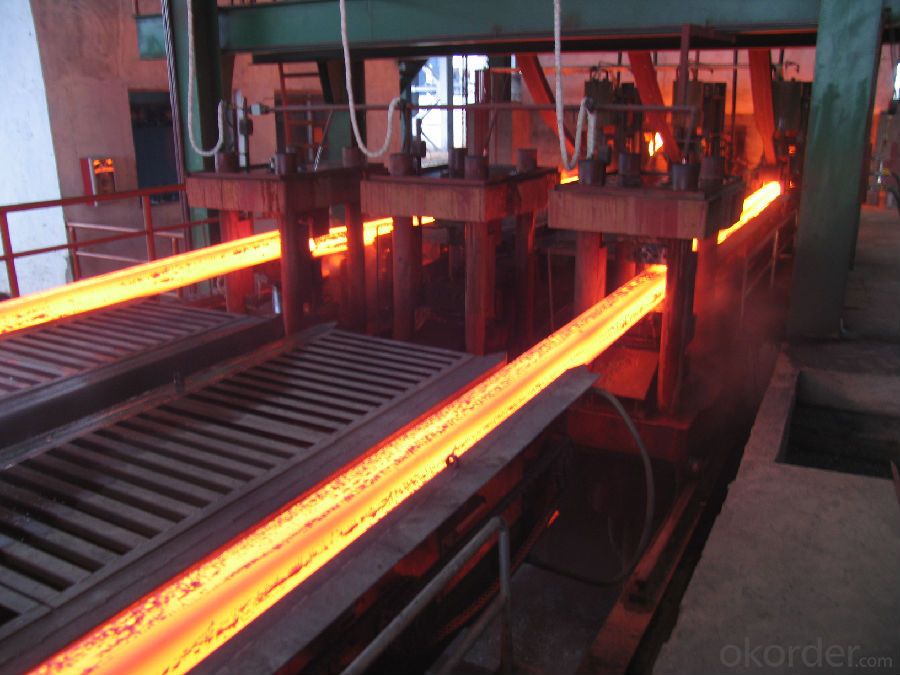
Specifications of Q235/3SP 175MM Blast Furnace Hot Rolled Steel Billet
Quality | Q/BQB 440-2003 | JIS G3312-1994 JIS G3321 | EN 10326-2004 | ASTM A653-02a |
EN 10327-2004 | (BASE PLATE) | |||
(BASE PLATE) | ||||
Commercial Steel | DC51D | SGCC SGLCC | DX51D+Z DX51D+AZ | CS Type A/B/C |
Forming Steel | St01,St02,St03 | SGCD1 SGLCD1 | FS Type A, Type B | |
Drawing | DC52D /DC53D | - | DX52D+Z DX52D+AZ | DDS TYPE A/C |
Steel | DX53D+Z DX53D+AZ | |||
Structural | S280GD (StE28) | SGC400 SGLC400 | S280D+Z DX54D+AZ | SS275 |
Steel | S350GD (StE34) | SGC440 SGLC440 | S350D+Z S350D+AZ | SS340 Class1 |
FAQ of Q235/3SP 175MM Blast Furnace Hot Rolled Steel Billet
We have organized several common questions for our clients,may help you sincerely:
1. How Can I Visit There?
Our company is located in Tianjin City, China, near Beijing. You can fly to Tianjin Airport Directly. All our clients, from home or aboard, are warmly welcome to visit us!
2. How Can I Get Some Sample?
We are honored to offer you sample.
3. Why choose CNBM?
Our delivery time about 15-20days for standard sizes, if you have other requirements like hardness, quanity and width ,it is about 20-40days. But don't worry we also try our best for the delivery time ,because time longer and our cost is higher.
- Q: How are steel billets used in the manufacturing of electrical components?
- The advantageous properties and suitability of steel billets make them commonly used in the manufacturing of electrical components. This process begins by producing steel billets, which are solid rectangular or square bars of steel formed through casting or hot rolling. When manufacturing electrical components, steel billets act as the raw material that undergoes various processes to become specific components. An example of this is the production of transformer cores, which are essential components in electrical transformers. Transformer cores made from steel billets offer high magnetic permeability, low hysteresis loss, and low electrical conductivity, making them perfect for magnetic induction applications. To manufacture transformer cores, the steel billets are heated and then shaped into thin laminations by passing them through a series of rolling mills. These laminations are stacked together and insulated with materials like varnish or paper, creating a core that efficiently transfers electrical energy between coils. Steel billets are also utilized in the production of electrical connectors, terminals, and busbars. These components require high strength, excellent electrical conductivity, and resistance to corrosion. Steel billets can be further processed using methods like forging, machining, or extrusion to create these components. Apart from transformers and electrical connectors, steel billets can be employed in manufacturing other electrical components such as motor cores, switchgear panels, and circuit breaker parts. The versatility of steel billets allows for the production of components with various shapes and sizes, catering to the specific requirements of the electrical industry. In conclusion, steel billets play a crucial role in the manufacturing of electrical components by providing a strong, durable, and cost-effective raw material that can be shaped and processed to meet the diverse needs of the electrical industry.
- Q: What is the role of steel billets in the manufacturing of agricultural machinery?
- Steel billets play a crucial role in the manufacturing process of agricultural machinery. These billets are essentially semi-finished steel products that are typically cast into a rectangular shape. They serve as the raw material for various components and parts of agricultural machinery. The use of steel billets provides several advantages in the manufacturing of agricultural machinery. Firstly, steel is known for its exceptional strength and durability, making it an ideal material for heavy-duty machinery that is subjected to harsh operating conditions. Steel billets, being the starting point of the manufacturing process, ensure that the final products possess the necessary strength and durability to withstand the demands of agricultural activities. Moreover, steel billets offer versatility in design and fabrication. Agricultural machinery requires a wide range of components with different shapes and sizes, and steel billets can be easily molded and machined to meet these requirements. This flexibility allows manufacturers to produce complex parts that are essential for the efficient operation of agricultural machinery. Additionally, steel billets provide consistent and reliable quality. The manufacturing process of steel billets involves strict quality control measures to ensure uniformity and adherence to industry standards. This consistency in quality translates into reliable performance and longevity of the agricultural machinery, reducing the need for frequent repairs or replacements. Furthermore, steel billets have excellent resistance to corrosion and wear, which is crucial for agricultural machinery exposed to various environmental elements. The use of steel billets ensures that the final products can withstand exposure to moisture, chemicals, and abrasive materials commonly encountered in agricultural settings. In summary, steel billets are integral to the manufacturing of agricultural machinery due to their strength, durability, versatility, consistent quality, and resistance to corrosion and wear. By using steel billets as the raw material, manufacturers can produce agricultural machinery that meets the demanding requirements of the agricultural industry, ensuring reliable and efficient performance in various farming applications.
- Q: How are steel billets used in the production of pressure vessels?
- Steel billets are used in the production of pressure vessels as the starting material for forging, rolling, or extrusion processes. These billets are heated and shaped into the desired form, such as plates or shells, which are then welded together to create the pressure vessel. The high strength and durability of steel billets ensure that the pressure vessel can withstand the high internal pressure and harsh operating conditions it may be subjected to.
- Q: What are the main applications of steel billets?
- Steel billets, which are semi-finished products, find application across a range of industries. The primary uses of steel billets include: 1. Construction: Structural steel production in the construction industry heavily relies on steel billets. Beams, columns, and other load-bearing elements in buildings and infrastructure are manufactured using steel billets. Their use in construction projects ensures strength, durability, and high load-bearing capacity. 2. Manufacturing: Steel billets serve as raw materials in the manufacturing industry for various metal products. Pipes, tubes, rods, wires, and other metal components are commonly manufactured using steel billets. The versatility of steel billets allows for easy shaping and forming into different sizes and shapes, making them ideal for manufacturing purposes. 3. Automotive Industry: The automotive industry extensively uses steel billets for producing components and parts. Engine parts, chassis components, suspension systems, and other critical automotive components are manufactured using steel billets. Steel billets offer exceptional mechanical strength and heat resistance, making them suitable for demanding automotive applications. 4. Machinery and Equipment: Steel billets are also utilized in the machinery and equipment industry for manufacturing gears, shafts, bearings, and other components requiring high strength and durability. Steel billets can withstand heavy loads and provide excellent resistance to wear and tear, making them essential for machinery and equipment manufacturing. 5. Energy and Oil Industry: The energy and oil industry widely employs steel billets in the production of pipes and tubes. Steel billets are used for constructing pipelines that transport oil, gas, and other fluids over long distances. The strength, corrosion resistance, and pressure containment provided by steel billets are crucial for such applications. In summary, the exceptional mechanical properties, versatility, and ability to be shaped into different forms make steel billets indispensable in various industries. Their applications span across construction, manufacturing, automotive, machinery, and energy sectors, contributing to the development and growth of multiple industries.
- Q: Billet production process
- Billets are produced by three process methods:First, through the steelmaking system of continuous casting equipment, from the direct pouring of molten steel billet;Two is the steel ingot produced by the steelmaking system or the continuous casting billet processed by the rolling equipment of the steel rolling system, and the three is the semi-finished product processed by the forging equipment of the steel ingot produced by the steelmaking system.
- Q: How can steel billets be customized for specific applications?
- Steel billets have the potential to be tailored to specific applications using a variety of techniques and processes. One commonly used method involves subjecting the billets to controlled heating and cooling cycles, known as heat treatment, in order to modify their mechanical properties. This can involve processes like annealing, quenching, tempering, or normalizing, which can help achieve desired levels of hardness, toughness, or ductility. Another way to customize steel billets is through alloying, which involves adding specific elements like chromium, nickel, or molybdenum to the steel composition. This enhances the properties of the billets to meet the requirements of different applications. For instance, adding chromium can improve corrosion resistance, while nickel can enhance strength and toughness. Moreover, the shape and size of steel billets can be customized. Depending on the intended use, billets can be cast into various shapes such as round, square, or rectangular, to better suit their purpose. Additionally, the dimensions of the billets can be adjusted to specific requirements, allowing for more efficient processing and minimizing material waste. Surface treatments can also be applied to steel billets to further customize them for specific applications. These treatments, including shot blasting, pickling, or coating, improve the surface finish, remove impurities, and provide protection against corrosion. Overall, the customization of steel billets for specific applications involves a combination of heat treatment, alloying, shaping, and surface treatments. Through these processes, the mechanical properties, composition, shape, and surface characteristics of the billets can be fine-tuned to meet the specific requirements of different industries and applications.
- Q: How are steel billets used in the manufacturing of power transmission equipment?
- Steel billets are an essential component in the manufacturing of power transmission equipment. These billets, which are solid blocks of steel, serve as the raw material for various parts and components of power transmission equipment. One of the primary uses of steel billets is in the production of gears and shafts. Gears are crucial in power transmission equipment as they help transfer rotational motion from one component to another. Steel billets are forged and machined into the desired shape and size to create strong and durable gears that can withstand the high forces and speeds associated with power transmission. Similarly, steel billets are also used in the manufacturing of shafts. Shafts are responsible for transmitting rotational motion and torque between different parts of the power transmission system. The strength and reliability of the shafts are crucial for the efficient functioning of power transmission equipment. Steel billets are shaped and machined to create robust and precise shafts that can endure the loads and stresses involved in power transmission. Furthermore, steel billets are used in the production of various structural components of power transmission equipment, such as housings and frames. These components provide support and protection to the internal mechanisms and ensure the equipment operates smoothly. Steel billets are forged, cut, and welded to fabricate sturdy and rigid structures that can accommodate the complex arrangements and dynamic forces of power transmission systems. In summary, steel billets play a crucial role in the manufacturing of power transmission equipment. They are used to create gears, shafts, and structural components that are essential for the efficient and reliable operation of power transmission systems. The strength, durability, and precision of steel billets contribute to the overall performance and longevity of power transmission equipment.
- Q: What are the specifications for steel billets used in the aerospace industry?
- The aerospace industry demands highly precise and stringent specifications for steel billets. These billets must adhere to specific standards to guarantee the safety and durability of aircraft components. Firstly, the steel utilized for aerospace billets must possess outstanding strength and toughness. It must exhibit a high tensile strength and the ability to withstand extreme forces and stresses encountered during flight. Additionally, the steel must demonstrate excellent fracture resistance to minimize the risk of catastrophic failure. Moreover, the steel billets must possess exceptional resistance to corrosion and oxidation. This is crucial as aircraft frequently operate in harsh environments, such as high altitudes and exposure to various chemicals. The steel should resist rust, pitting, and other forms of degradation that can compromise its structural integrity over time. Furthermore, the steel billets employed in aerospace applications must exhibit precise dimensional tolerances and uniformity. They should be manufactured according to exact specifications to ensure consistency in the production of aircraft components. This entails precise size, shape, and surface finish, which are vital for proper fitting and assembly. Regarding chemical composition, the steel used for aerospace billets may vary depending on the specific application and component being manufactured. However, it typically includes elements like carbon, manganese, chromium, nickel, and molybdenum. These alloying elements enhance the mechanical properties of the steel, such as hardness, toughness, and heat resistance. Additionally, the steel billets utilized in the aerospace industry undergo rigorous testing and quality control procedures. This includes non-destructive testing methods such as ultrasonic inspection, magnetic particle inspection, and dye penetrant inspection to identify any internal defects or discontinuities. In summary, the specifications for steel billets used in the aerospace industry encompass exceptional strength, toughness, corrosion resistance, dimensional accuracy, and precise chemical composition. These stringent requirements ensure the reliability and safety of aircraft components, enabling them to withstand the demanding conditions experienced during flight.
- Q: How are steel billets made?
- The process of making steel billets is known as casting. It begins by melting raw materials like iron ore, coal, and limestone in a blast furnace until they become molten iron. This molten iron is then further purified in either a basic oxygen furnace or an electric arc furnace to adjust its composition and remove impurities. Once the desired composition is achieved, the molten iron is poured into a continuous casting machine. This machine contains a copper mold that is cooled by water, which shapes the molten iron into a solid billet. As the molten iron is poured into the mold, it cools rapidly and solidifies, creating a continuous length of solid steel. The billet is then cut to the desired length and moved to a storage area to cool down even more before undergoing further processing. The cooling process is vital as it helps improve the internal structure and overall quality of the billet. After cooling, the steel billets can undergo various treatments, such as heat treatment or surface conditioning, to enhance their mechanical properties and surface finish. They can also be processed further into different shapes and sizes through methods like rolling, forging, or extrusion to meet specific requirements of customers. In summary, the production of steel billets involves melting the raw materials, purifying the molten iron, casting it into a continuous mold, and subsequently cooling and processing the solid billets. This process guarantees the production of high-quality steel billets that are essential components for industries such as construction, automotive, and manufacturing.
- Q: What are the different surface defects found in alloy steel billets?
- Some common surface defects found in alloy steel billets include cracks, laps, seams, scabs, and surface scale. These defects can occur during the manufacturing process or as a result of handling and transportation.
Send your message to us
Q235/3SP 175MM Blast Furnace Hot Rolled Steel Billet
- Loading Port:
- Tianjin
- Payment Terms:
- TT OR LC
- Min Order Qty:
- 2000 m.t.
- Supply Capability:
- 30000 m.t./month
OKorder Service Pledge
OKorder Financial Service
Similar products
Hot products
Hot Searches
Related keywords
